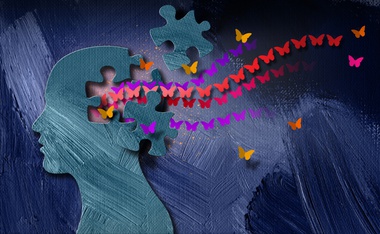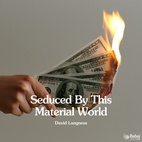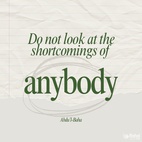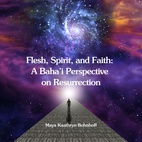The views expressed in our content reflect individual perspectives and do not represent the authoritative views of the Baha'i Faith.
One of the primary principles of the Baha’i teachings calls on everyone to conduct their own independent investigation of the truth – to look deeply into the realities of things.
We investigate reality because we don’t know whether statements we encounter are in accordance with reality or not. As Abdu’l-Baha said in a speech he gave in Washington, D.C. in 1912:
The first teaching of Baha’u’llah is the duty incumbent upon all people to investigate reality. What does it mean to investigate reality? It means that man must forget all hearsay and examine truth himself, for he does not know whether statements he hears are in accordance with reality or not. Wherever he finds truth or reality, he must hold to it, forsaking, discarding all else; for outside of reality there is naught but superstition and imagination.
Have you ever read something that appeals to you so much that you want it to be true – that you really wish you could make it become true? This kind of wishful thinking can often end up leading us down blind and unfruitful alleys.
RELATED: The Overview Effect: UN International Day of Human Space Flight
An Astronaut’s Mystical Encounter
After Edgar Mitchell famously became the sixth man to walk on the Moon, on board Apollo 14 on the flight home, he had an unforgettable experience that changed his life. The spacecraft that he was in was slowly rotating, making sure that on the voyage home no one side would become too hot or too cold. That gave Mitchell a panoramic view of the Moon, Earth and Sun, and many more, brighter, stars than he would ever see from the Earth’s surface.
Mitchell, rapt in the wonder of what he was seeing, said he “realized that the molecules of my body and the molecules of the spacecraft had been manufactured in an ancient generation of stars.”
This would hardly have been strange for a man of his training, but for him “it wasn’t just intellectual knowledge – it was a subjective visceral experience accompanied by ecstasy – a transformational experience.”
Spiritually Transformative Experiences
Looking back on this now, we might describe what Mitchell experienced as a Spiritually Transformative Experience (STE). During his experience, he was “seeing things in their separateness, but experiencing them viscerally as a unity, as oneness, accompanied by ecstasy.”
The concepts of oneness and unity in his account are consistent with those of many others, and are also consistent with the Baha’i writings, expressed here by Abdu’l-Baha:
Reflect upon the inner realities of the universe, the secret wisdoms involved, the enigmas, the inter-relationships, the rules that govern all. For every part of the universe is connected with every other part by ties that are very powerful and admit of no imbalance, nor any slackening whatever.
Mitchell felt that what he had experienced was so extraordinary that he had to make efforts to understand it. Heading off to the library once he returned to Earth, he found nothing in the available scientific literature. However he thought he did find something that was helpful to him in esoteric books. Like many after him, he thought that some of the newer concepts from the physics of quantum phenomena could be borrowed – and extended – to help him scientifically understand what he had felt emotionally and spiritually.
The problem: there isn’t sufficient evidence, based on our knowledge of the way the world works at present, to back up extending these concepts in the way that he wanted. To help us understand where Mitchell wanted to go, and what the pitfalls are, let’s look at two concepts in quantum mechanics: entanglement and the holographic principle.
Entanglement
Quantum entanglement occurs when two sub-atomic particles, which were once close neighbors and then become distant, retain a connection. Change anything about one of these entangled particles, let’s say its speed, and the speed of the other particle is likewise changed, instantly, and in exactly the same way.
The connection between the two particles is non-local. This entanglement may seem strange, but it is a well-known concept in physics that is now helping us build very small circuits, called qubits, that power highly specialized computers for cracking codes. We do not yet know why or how entanglement occurs – only that it does.
The Holographic Principle
The holographic principle is a useful mathematical tool used in cosmological string theory. These theoretical “strings” are unimaginably small two-dimensional constructs that no one has actually detected yet. Just like a hologram, where a three-dimensional image can be seen in a two-dimensional picture, the holographic principle allows the reconstruction of all the information in a volume by “reading” the information on the surface of that volume. Applied to the Big Bang theory, this holographic principle becomes the “holographic universe:” all the information inside the universe is theoretically recorded on the “edge” of the universe.
Explaining Ineffable Experiences
Mitchell wanted so much to explain his ineffable experience, which could not be expressed adequately in words, by using our existing knowledge of the way physics works. Accordingly, he attempted to use what we now know to reach his goal. First, he said that the existence of entanglement showed that every particle in the universe is connected – and that because all particles are connected, including particles in our brains, that meant the universe is pervaded by a non-local consciousness that exists via the mechanism of entanglement.
Mitchell also linked the holographic principle to a concept he borrowed from Theosophy known as “the Akashic Record.” In short, he said “nature has a history, and you can retrieve that history in the Akashic field. The quantum hologram is a mechanism that allows that to be true.”
In the interests of investigating reality, let’s see how far science has actually gone in applying entanglement and the holographic principle. At the time of this writing, the largest objects that have been confirmed to be entangled are tiny metal discs, no more than 15 millionths of a meter across. Further, they have had to be cooled down to the incredibly low temperature of below minus 270 degrees Celsius. A research group did recently claim to have achieved entanglement of a tiny animal called a tardigrade on top of one of two qubits; however no other researchers have so far been able to reproduce the results, and further analysis showed the original experiment failed to account for much less interesting side effects that contaminated their results.
We’ve made even less progress with the holographic principle, which remains a tool in a mathematician’s tool-box, a convenient way of reducing the time it takes to perform calculations required by string theory, and nothing more. No one has actually read information of a two-dimensional plane anywhere, let alone at the edge of the universe. Certainly no scientist has provided any evidence of being able to read someone’s life history from a “quantum hologram.”
Despite the scientific evidence we now possess, every sympathy must be extended to Edgar Mitchell, and to everyone who searches for answers. Living with the inexplicable, especially when it has changed your entire outlook, your way of thinking about other people and the world, can be mystifying. But this type of wishful thinking – over-extending or over-applying our existing scientific knowledge about the way things work – is called a “fallacy of weak induction,” meaning that the evidence necessary to support the proposal is too weak at the moment to support a conclusion.
RELATED: The Sparkle of Sagacity: Separating the Truth from Error
The Human Limitations of Knowledge
Science cannot explain everything. It may be that many things about ourselves and our universe shall forever remain out of our grasp, as our feeble intellects and restricted perceptions limit what we can empirically know. The Baha’i teachings confirm those all-too-human limitations, as in these two passages from Baha’u’llah’s mystical volume The Hidden Words and his Most Holy Book:
Didst thou behold immortal sovereignty, thou wouldst strive to pass from this fleeting world. But to conceal the one from thee and to reveal the other is a mystery which none but the pure in heart can comprehend.
He, verily, hath willed for you that which is yet beyond your knowledge, but which shall be known to you when, after this fleeting life, your souls soar heavenwards and the trappings of your earthly joys are folded up.
Without question, however, we should keep trying to extend the limits of what we can know, and continue testing ourselves against the limitless expanse of our universe and the untrammeled depths of our being. As the esteemed physicist David Bohm once mused in a private moment:
The form of knowledge is to have at any moment something essential, and the appearance can be explained. But then when we look deeper at these essential things they turn out to have some feature of appearances. We’re not ever going to get a final essence which isn’t also the appearance of something.
As we try harder and investigate further, we will be able to plumb deeper and deeper into the infinite mysteries of our world. Who knows what we may be able to discover?
















Comments
Sign in or create an account
Continue with Googleor